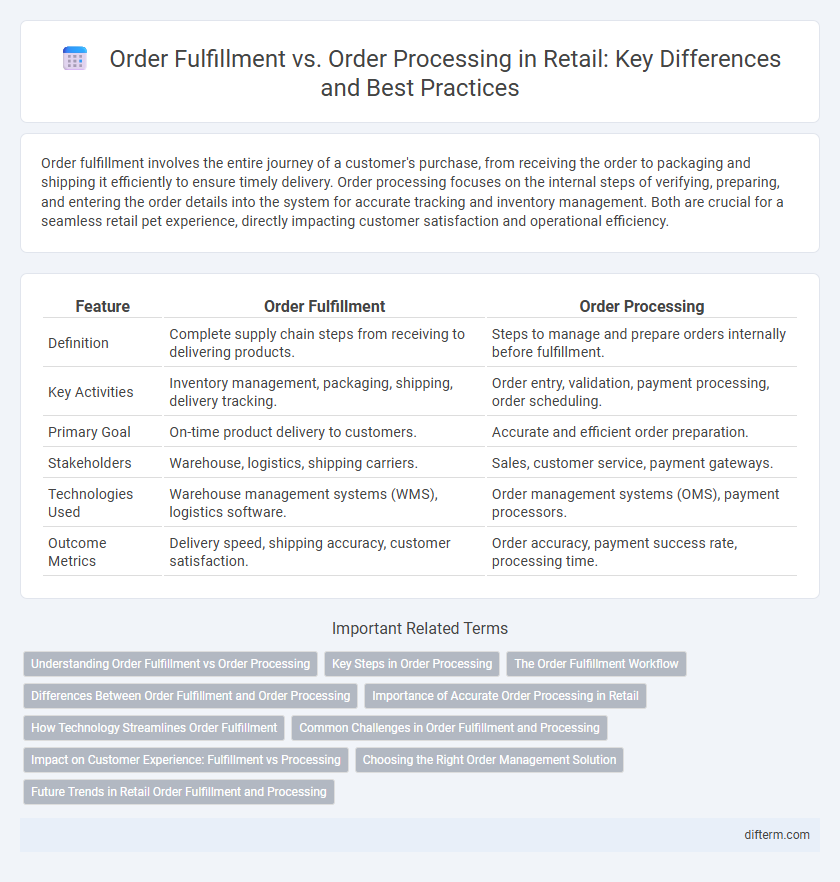Order fulfillment involves the entire journey of a customer's purchase, from receiving the order to packaging and shipping it efficiently to ensure timely delivery. Order processing focuses on the internal steps of verifying, preparing, and entering the order details into the system for accurate tracking and inventory management. Both are crucial for a seamless retail pet experience, directly impacting customer satisfaction and operational efficiency.
Table of Comparison
| Feature | Order Fulfillment | Order Processing |
|---|---|---|
| Definition | Complete supply chain steps from receiving to delivering products. | Steps to manage and prepare orders internally before fulfillment. |
| Key Activities | Inventory management, packaging, shipping, delivery tracking. | Order entry, validation, payment processing, order scheduling. |
| Primary Goal | On-time product delivery to customers. | Accurate and efficient order preparation. |
| Stakeholders | Warehouse, logistics, shipping carriers. | Sales, customer service, payment gateways. |
| Technologies Used | Warehouse management systems (WMS), logistics software. | Order management systems (OMS), payment processors. |
| Outcome Metrics | Delivery speed, shipping accuracy, customer satisfaction. | Order accuracy, payment success rate, processing time. |
Understanding Order Fulfillment vs Order Processing
Order fulfillment encompasses the entire process from receiving customer orders to delivering products, including inventory management, packaging, and shipping. Order processing refers specifically to the steps involved in verifying, entering, and preparing the order details within the system before fulfillment. Efficient integration of order processing and fulfillment improves customer satisfaction by reducing errors and delivery times in retail operations.
Key Steps in Order Processing
Order processing involves key steps such as order receipt, verification, inventory check, payment authorization, and order confirmation, ensuring accuracy before fulfillment. Efficient order processing streamlines operations by promptly managing customer requests and updating inventory systems. This foundation enables timely and accurate order fulfillment, which includes picking, packing, shipping, and delivery to customers.
The Order Fulfillment Workflow
The order fulfillment workflow encompasses the entire process from receiving an order to delivering the product to the customer, involving critical steps such as inventory management, picking, packing, and shipping. Efficient order fulfillment reduces delivery time and enhances customer satisfaction by ensuring accurate and timely shipments. Retailers leverage automation and integrated warehouse management systems (WMS) to optimize inventory tracking, streamline picking accuracy, and accelerate the packing process within this workflow.
Differences Between Order Fulfillment and Order Processing
Order fulfillment encompasses the entire sequence from receiving the order to delivering the product to the customer, including picking, packing, shipping, and handling returns, while order processing primarily involves verifying, entering, and confirming the order details within the system. Order fulfillment requires extensive logistics coordination and inventory management, whereas order processing is centered on data accuracy and transaction processing. Distinguishing these functions enhances operational efficiency and customer satisfaction in retail management.
Importance of Accurate Order Processing in Retail
Accurate order processing is crucial in retail to ensure timely and correct fulfillment, directly impacting customer satisfaction and retention. Errors in order processing can lead to inventory discrepancies, increased return rates, and operational inefficiencies that drive up costs. Streamlined order processing systems enhance supply chain transparency, reduce shipping delays, and support scalable growth in competitive retail markets.
How Technology Streamlines Order Fulfillment
Technology streamlines order fulfillment by automating inventory management, real-time tracking, and demand forecasting, resulting in faster and more accurate shipments. Advanced warehouse management systems (WMS) integrate with order processing platforms to reduce errors and optimize picking, packing, and shipping workflows. Robotics, AI, and cloud-based solutions enhance operational efficiency, minimize labor costs, and improve customer satisfaction in retail supply chains.
Common Challenges in Order Fulfillment and Processing
Order fulfillment and order processing frequently face challenges such as inventory inaccuracies, delayed shipping, and errors in order picking, which can disrupt the supply chain and reduce customer satisfaction. Inefficient warehouse management and lack of real-time tracking systems contribute to poor order visibility and slower fulfillment times. Addressing these issues requires integrated technology solutions and streamlined workflows to ensure timely and accurate delivery.
Impact on Customer Experience: Fulfillment vs Processing
Order fulfillment directly influences customer experience by ensuring timely delivery, accurate packaging, and real-time tracking, which boosts satisfaction and loyalty. Order processing enhances this experience by efficiently managing inventory, payment validation, and order entry accuracy to reduce errors and delays. Together, seamless fulfillment and processing create a reliable shopping journey that meets or exceeds customer expectations in retail.
Choosing the Right Order Management Solution
Order fulfillment involves the complete process of receiving, packaging, and delivering customer orders, while order processing focuses on the internal handling of order data and inventory management. Selecting the right order management solution requires analyzing factors such as real-time inventory tracking, integration capabilities with e-commerce platforms, and automation of shipping logistics. Effective alignment of these features ensures streamlined operations, reduced errors, and enhanced customer satisfaction in retail.
Future Trends in Retail Order Fulfillment and Processing
Emerging technologies such as AI-driven automation and real-time data analytics are revolutionizing retail order fulfillment and processing by enhancing speed, accuracy, and customer experience. Integration of omnichannel strategies and autonomous delivery systems enables retailers to meet growing consumer demands for faster, more flexible delivery options. Blockchain technology is increasingly being adopted to improve transparency and traceability in order processing, ensuring secure and reliable transactions throughout the supply chain.
Order Fulfillment vs Order Processing Infographic

 difterm.com
difterm.com